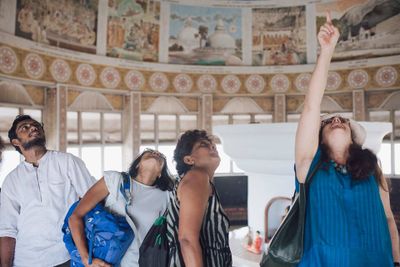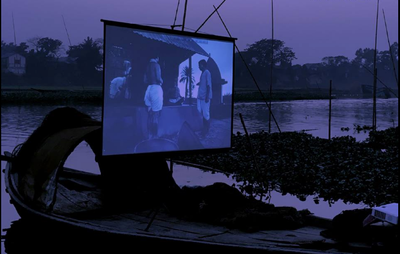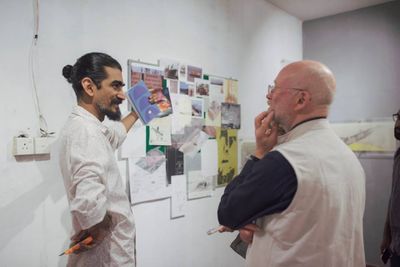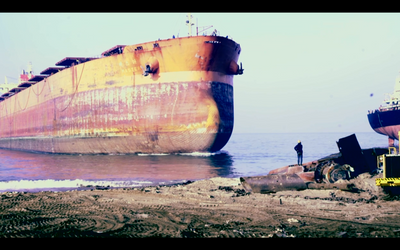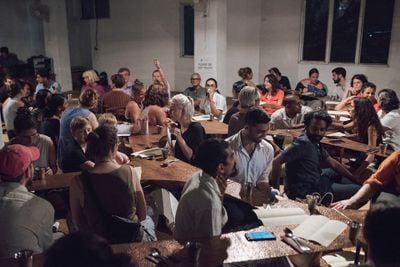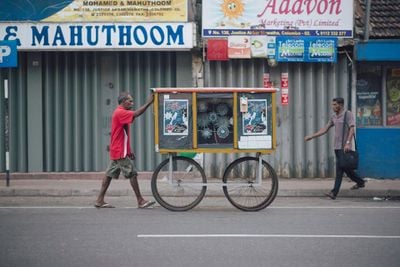Colomboscope 2019: Cross Currents and Dissonance
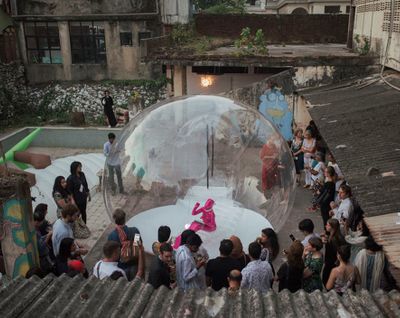
Henry Tan & Partners, Merchants of Merchants (2019). Performance. Colomboscope 2019: Sea Change, Colombo (25–31 January 2019). Courtesy Colomboscope.
On the rooftop of the former Rio Hotel complex in Colombo, it was hard to ignore the high-rise buildings, still under construction, blocking all but a sliver of what used to be an open view over Slave Island, once an island on Beira Lake that housed slaves in the 19th century, and now a downtown suburb. The hotel was set alight during the anti-Tamil 'Black July' riot on 24 July 1983, a response to a Tamil militant ambush the day before, which triggered a civil war in Sri Lanka that lasted until May 2009. Along with Barefoot Gallery and nightclub B52, the Rio complex hosted Sea Change, the sixth edition of the interdisciplinary contemporary arts festival Colomboscope (25–31 January 2019).
The Rio site also featured in the festival's 2015 edition, which Sea Change curator Natasha Ginwala also curated—thus highlighting the changes that have ensued in just a few years, with the horizon all but swept away.
Bringing together around 30 creative practitioners—including artists, curators, researchers, and musicians—from across South Asia and beyond, Sea Change invoked Sri Lanka's ancient maritime legacy in the Indian Ocean, which 'gave shape to a cosmopolitan lineage of social pluralism and cultures of connectedness', from China to Mozambique.
A walking tour organised by researcher Chryshane Mendis offered an introduction to the intersecting histories of the old port area, which was originally built by the Dutch East India Company. While engaging with the Dutch past, Mendis did not directly mention the Chinese present, which was visible from the viewing platform of a Buddhist temple perched on a concrete cross-arches above the port and Maritime Museum. We were told not to take photos of the massive land reclamation project below: the site of a China Communications Construction Company development that The Guardian dubbed the 'New Dubai'. Instead, we were led into a nearby police academy to see the remnants of the old Colombo fortress wall, where black or 'Kaffir' slaves were first kept in an area between wall and sea. Apparently it was only after a violent murder in the 1840s that the Dutch moved slaves to the area still known as Slave Island, now being eroded by property developers.
Feeling acclimatised, it was back to the crumbling cinema in the Rio complex—a superbly evocative space to screen works that speak of the ruins of modernity—to watch Molla Sagar's Titas the River (2016). Sagar's documentary was the result of a long engagement with the riverine Malo community in Bangladesh, and captures the lives of bodies crafted from a life on water. The swift motion of narrow wooden craft, river races, a sailor's gymnastic ability to smoke a cigarette while doing a headstand on a moving boat, are all documented in footage that is seamlessly combined with music and song.
The reference to Titas in Sagar's title comes from a 1973 Ritwik Ghatak film Titas Ekti Nodir Nam (Titas is the Name of a River), which Sagar featured in his documentary on a portable screen floating on the river. Images of Ghatak's film within Sagar's film add a sense of self-awareness of Sagar's place within a lineage of ethical filmmaking. Throughout, difficult conversations happen on land or on the banks, confronting the changing demographics of the area, ecological damage, and the attrition of indigenous communities. Speaking directly to the camera, 85-year-old Dobraz Mian suggests that it is the responsibility of the ruling class to provide jobs and livelihoods, and not just make a profit. In another sequence, the Malo complain to Muslim fishermen who have encroached heavily on their livelihood after being invited to share fishing rights on the river.
Ginwala's exhibition included a publication project organised by the publishing-based curatorial practice Scroll, curated by Aziz Sohail, which weaves together projects by some of Sea Change's participating artists. Practices speak quite directly to each other, both in this presentation and in the festival exhibition as a whole, as is the case with Ranjit Kandalgaonkar and Hira Nabi, both working on shipbreaking yards in Alang in India and Gadani in Pakistan. During the festival, a discussion between Sohail, Nabi, Kandalgaonkar and Sri Lankan photographer Abdul Halik Azeez at Barefoot gallery took place; and like with many Indo-Pakistani friendships borne out of artistic collaboration, it took a while for speakers to get beyond the excitement of being able to meet and speak in person, with sites like Colombo offering the possibility of such convening and alliance.
Kandalgaonkar comes to visual practice from urban research and the project that he presented as part of the exhibition at the Rio complex, Basic Design (2019), is based on a combination of research into the Alang shipyards and personal archives. A series of notations that look at the processes by which ships are guided into the yards and taken apart—which make for beguiling pencil drawings, some factual and others speculative—are presented as part of a densely layered bulletin board that also narrates Kandalgaonkar's own father's vessel meeting its end at Alang, with the artist managing to retrieve a steering wheel that he plans to turn into a table.
For Nabi, the 'Ocean Master', a container ship at the shipyards of Gadani, is the anthropomorphised subject of her docu-fictional film All That Perishes At The Edge of Land (2018), which narrates a conversation between the vessel, personified in a poetic female voice, and shipyard workers. While the images and dialogue in Nabi's work expose the role of capital in condemning labour to dangerous, arduous, precarious work, the sheer wonder of a giant ship's massive metal carcass is hard to resist. The trouble with boats, especially their spectacular rusting decay, is that their scale and beauty generates a sense of awe even as they leach toxic waste.
Fazal Rizvi's 30-minute sound piece, These Fissures in the Deep (2019), presented as part of the Scroll curatorial, was accompanied by a small publication that viewers were encouraged to explore while listening. Rizvi works with experimental text, often as typographic image by way of concrete poetry, and has been working around the Karachi harbour and coastline for a few years. His exploration of regionally rooted maritime lore in this project has a literary sensibility, and plays with the idea of Sri Lanka as the jewel island, while destabilising such beauty with questions that appear in mirrored text: 'Why such symmetry? What about dissonance? What are the cracks within this image?' Such queries seem important to consider in an exhibition predicated on the sea as a symbol of connection.
Nevertheless, Rizvi sets out to seduce in These Fissures in the Deep, with images of coral, marjan, and blue sapphires twinkling in the waves. A seduction that continues until you unfold the last of six sheets of paper to find a map of Balochistan—Pakistan's largest province, resource-rich and mired in conflict—with sections clipped out and scattered across the page. The work makes veiled references to the China–Pakistan Economic Corridor and the resulting development of transportation networks, including an integral port in Gwadar, a focal point for Baloch separatism, not to mention the militarisation of Balochistan and the enforced disappearances of nationalists and activists resisting such developments—a subtle warning, perhaps, to friends in Sri Lanka where Chinese involvement in the Hambantota port has been occupying the news.
In general, the sea became more than a mere site for research visits in Sea Change, particularly among works produced directly in response to the festival's invitation to artists from across generations to openly experiment. Mayantha Perera's haunting oil paintings from 2018, of undersea scenes of death and burial informed by the aftermath of the 2004 tsunami, recalling the artist's memories of searching for his grandfather after the disaster; while Catharina Danial's 'Self-Portrait' series (2018) reflects an embodied relationship to North Sri Lanka's underwater terrain, with coral threaded through with human hair, either dunked in an aquarium or strung up to catch the breeze. Isuru Kumarasinghe's Listening In (2019) was similarly experimental: a sound-based sculptural work with audio tracks played through hollow bamboo, which distorted the sounds as if heard underwater.
The programme around the week-long exhibition included a series of international performances and happenings by practitioners from beyond South Asia, including a mangrove-themed dinner with the duo Cooking Sections (Daniel Fernández Pascual and Alon Schwabe), whose CLIMAVORE project develops sustainable menus in the context of food scarcity due to climate change. Collective Feeding concerts for migratory birds by Swiss artist Robin Meier were particularly focused on the ubiquitous black crows of Indian Ocean cities. A TBA21 Academy convening organised by Chus Martínez in collaboration with Julieta Aranda and Natasha Ginwala included exhibiting artists Anoli Perera, smell researcher Sissel Tolaas, The Many Headed Hydra (Emma Haugh and Suza Husse), Jasmine Nilani Joseph and a performance, Sundaram, by Hania Luthufi, whose album included in the exhibition, Eternal Tides, is a compilation of international coastal musical forms.
There were local interventions, too, like Firi Rahman's installation Taste Karanthethé, which mimicked a food vendor's cart and moved between the Rio complex and Galle Face Green, a five-hectare ocean-side urban park considered the largest open space in Sri Lanka, whose promenade is bordered by the historic Galle Face Hotel. The cart is part of a longer-term project documenting oral histories of the disappearing informal street economies of Sri Lanka, and for Colomboscope it was presented along the beachfront, an area being transformed by gentrification.
Taste Karanthethé touches on the fact that tourist-friendly Sri Lanka has the capacity to become a node on the Indian Ocean's exhibition network—a potential that was confirmed by Colomboscope's recent announcement to convert into a biennial event with Ginwala at the helm. Indeed, the theme of Sea Change aligns with other contemporary art sites located in ports along the Indian Ocean, such as the Sharjah and Kochi-Muziris, with claims to cosmopolitan, polyglot identities bolstering globalised art-world relevance while ostensibly countering ethno-nationalist narratives—all while remaining insistent on the notion of each site as a historic centre, not without a tinge of nostalgia.
The idea of the tourist and art-world traveller as harbinger of capitalist dreams and globalised consumption came together in photographer Abdul Halik Azeez's project On this picture you can see a local man present his jumping skills (2019), a photographic series developed by tracking the most popular hashtags for the island on Instagram. Image after image repeats the same tropes of Sri Lanka as an island paradise, but devoid of local realities. Bikini bodies and holiday poses repeat across several walls, at first slightly banal, then embarrassing in their voyeurism, and then increasingly grotesque, in a parody of the colonial encounter as the local subject is rendered invisible. Offering a counterpoint was Dominic Sansoni's archive of black and white photographs documenting traditional coral architecture and local fishing communities in the Maldives taken between the 1980s to 2006: a sensitive account of a world fast receding to the pressures of economic shifts and climate change.
More unnerving than Azeez's Instagram taxonomy, however, was Venuri Perera's I dance for _________ (2019), a performance staged in B52, the basement club of the Grand Oriental Hotel, that involved punters paying 100 rupees in exchange for fake notes that would buy 'garlands' to adorn dancers performing to mostly Bollywood tunes. Perera's performance transported me back to Karama, Dubai, circa 2001, when a friend of an ex was involved with a dancer, so we were dragged to watch her night after night, so that nobody else did. I was often the only woman watching in an audience of migrant workers on their night off, and it was the heat from their gaze that was the only thing missing in Perera's faithful recreation of a dance bar.
In the room next door, the slide show Shore Leave (2010–2011) by Raqs Media Collective told the story of a sailor taking his day off on land with a prostitute; and I could have sworn that one sequence in the work, in which 'a price is settled by hand signs', came from a story I might have told about a similar transaction between prostitute and client—both itinerant workers—in a boomtown port city. I left wondering if artists and curators in search of the next art-world centre might instead consider connecting already existing exhibition sites to each other in a more active regional network, with a greater capacity to address shared anxieties. —[O]

